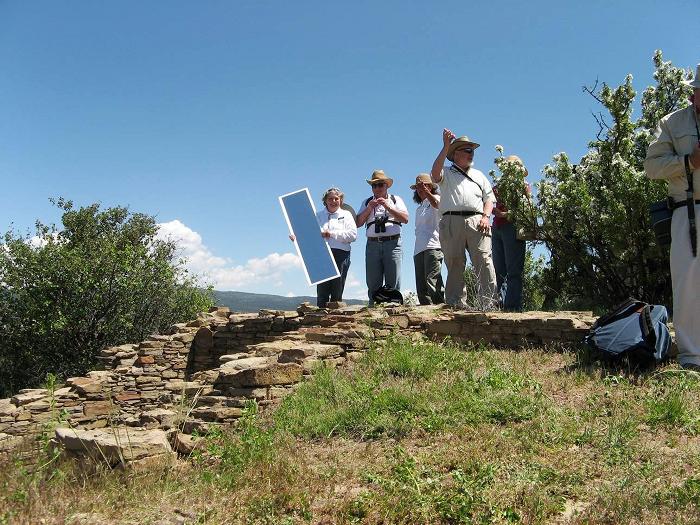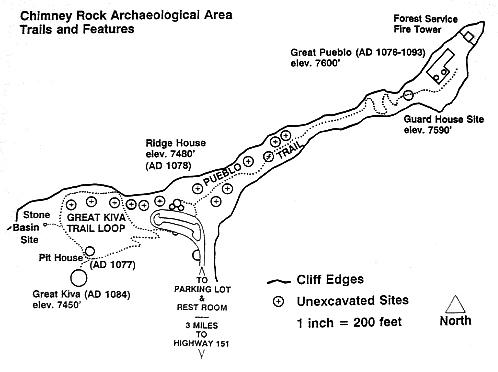 |
Canku Ota
|
 |
|
(Many Paths)
|
||
|
An Online Newsletter
Celebrating Native America
|
||
|
August 2017 - Volume
15 Number 8
|
||
|
|
||
|
Ancestral Puebloans
Used Fire To Communicate Across Vast Distances
|
||
|
by Luke Perkins - (Durango,
CO) Herald Staff Writer
|
||
In 1933, President Franklin D. Roosevelt set about bringing the United States out of the Great Depression with his New Deal. These efforts included a number of things that became a part of everyday life, such as the ending of Prohibition, the establishment of Social Security and the creation of the Civilian Conservation Corps, which put unemployed men to work in a time when jobs were hard to find. In the Southwest, there are multiple example of projects taken on by the CCC, including the Lions Den shelter near Fort Lewis College, many of the trails and roads at Mesa Verde National Park and, until it was removed in 2010, the fire lookout tower at Chimney Rock National Monument. The lookout tower has quite the history: It was built in 1940, abandoned in the '50s after it caught fire, reconstructed in 1987 for viewing the ancestral Puebloan site and ultimately removed because it interfered with the observation of astronomical events. What's even more interesting, however, is the history of the ground on which the tower was built. Beneath its foundation is a 1,000-year-old fire pit that may have been a piece of a vast communication system that linked ancestral Puebloan sites in the Southwest.
Linking distant sites But there wasn't a connection to long-range communication until 1990 when Kathy Freeman, a high school student from Farmington, conducted an experiment using large mirrors as part of a science fair project. Using mirrors, Freeman was able to reflect light from Chimney Rock to Huerfano Mountain, which is on protected Navajo Nation land in northern New Mexico. That land also has evidence of large bonfires. From Huerfano, light was relayed to Pueblo Alto in Chaco Culture National Historic Park. "It totally worked. You could see the flashes of the mirrors, and in 2007, we recreated that experience," Coleman said. That experiment was more than a duplication of Freeman's. Researchers placed crews at a number of sites around the Southwest, including Aztec Ruins National Monument, the Far View site at Mesa Verde National Park and Salmon Ruins in Bloomfield. Using a similar methodology, scientists were able to connect many ancestral Puebloan sites in the area, but hazy conditions meant the connection between Huerfano and Chimney Rock was not achieved. While researchers used mirrors, it is believed that Native American tribes could have used large fires to achieve similar results. But what would such long-range communication have been used for? Commerce and more While this is one possible reason identified by Western scholars for using fire to communicate across long distances, it isn't the only one. The oral histories of tribes with a lineage to the ancestral Puebloans paint different pictures of the pueblos, how they interacted and why. Carey Vacenti, assistant professor of sociology at Fort Lewis College, is a member the Jicarilla Apache tribe and also has Pueblo and Southern Ute ancestry.
Vacenti said the oral histories taught to him from his Pueblo lineage describe sites in the Southwest, particularly Chaco Canyon, in ways that non-Native Americans are not willing to accept because of the sentiment around oral accounts. "Much of the oral history is ignored by anthropologists and archaeologists because they consider it to be unreliable, and yet you learn the Pledge of Allegiance not probably by reading it but by reciting it, and nobody gets those words wrong," he said. Tim Hovezak, archaeologist at Mesa Verde, described properly using oral histories as "one of the biggest challenges in archaeology." This is because scholars have to be able to corroborate these accounts with material evidence and interpret from there, Hovezak said, which can be difficult because of the number of Native American tribes affiliated with sites like Mesa Verde. "They all have their own take and their own history of this place," he said. The histories passed down to Vacenti describe Chaco Canyon as a religious mercantile hub. The area flourished for more than 300 years beginning in the mid-800s A.D. "It was kind of the equivalent of a, what would you call it, like a religious bookstore. It's kind of like you go to a religious bookstore and get all kinds of religious paraphernalia. You can get different types of bibles, you can get prayer beads … you can get things like that," Vacenti said. This trade would include a number of items brought north from Central America, such as shells, copper bells, macaw feathers and chocolate. Vacenti said the long-range signaling system was connected with this trade, and fires were used to notify outlying settlements that people from the south had arrived, according to his oral histories.
Manipulating landscapes Some sites in the region appear to have been ritualistically burned during their abandonment, Hovezak said in an e-mail. But corroborating evidence is needed when attributing burning to the ancestral Puebloans because of the lack of a written record, he said. Without it, most fires at Mesa Verde are attributed to natural causes. George San Miguel, natural resources manager for Mesa Verde, said there is evidence that points to a broader use of fire at the national park. According to a study published by San Miguel in 2013, there is a significant rise in charcoal accumulation at the park during the peak of habitation by ancestral Puebloans with a decrease after emigration from the area. The study says the increased charcoal accumulation "lends strong evidence to the importance of Native American use of fire to manipulate landscapes." The study goes on to say this would be the first instance of extensive fire use by ancestral Puebloans in the Southwest, but this isn't particularly a surprise based on Native American's history of environmental manipulation through fire. "This is not shocking or anything like that," San Miguel said. Perhaps the most prominent example of Native American use of fire is in the Southeast where slash-and-burn practices were used to clear land for farming before colonization. There are a number of other accounts of fire use by Native Americans, including hunting and herding of buffalo in the Great Plains, as well as a list of logical reasons for its use. San Miguel said fire could be selectively used to keep vegetation in particular growth stages when it is more nutritious and allow for the support of more game animals in an area for the purpose of hunting. Fire could also be used to manufacture an expanded "edge effect," the area where two ecosystems meet, such as the joining of plains and a forest, where there is increased biodiversity. It could also be used to essentially groom an area, removing underbrush and easing travel and hunting within it. Without a written record, it is hard to say exactly why fire use was expanded during the settlement of Mesa Verde. "This is speculation. We don't know this for fact, but these are logical reasons to do this kind of thing," San Miguel said. |
|||||||
|
|
|
|
||
|
|
||
| Canku Ota is a free Newsletter celebrating Native America, its traditions and accomplishments . We do not provide subscriber or visitor names to anyone. Some articles presented in Canku Ota may contain copyright material. We have received appropriate permissions for republishing any articles. Material appearing here is distributed without profit or monetary gain to those who have expressed an interest. This is in accordance with Title 17 U.S.C. Section 107. | ||
|
Canku Ota is a copyright ©
2000 - 2017 of Vicki Williams Barry and Paul Barry.
|
||
 |
 |
|
|
The "Canku
Ota - A Newsletter Celebrating Native America" web site and
its design is the
|
||
|
Copyright ©
1999 - 2017 of Paul C. Barry.
|
||
|
All Rights Reserved.
|
||



